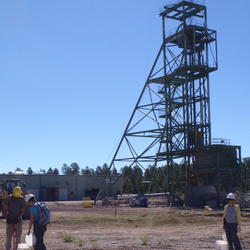Questions We Answer
Questions We Answer
Examples of how our integrated teams of scientists from the Environmental Health Program (Contaminant Biology and Toxic Substances Hydrology) answer high priority environmental health science questions.
Filter Total Items: 9
How are Mercury Sources Determined?
USGS scientists use innovative isotopic identification methods to determine mercury sources in air, water, sediments, and wildlife.
Is Uranium in Water Resources near the Grand Canyon a Health Hazard?
The public is concerned that uranium in natural geologic formations, mine tailings, dusts, water, and other geologic materials can pose a health hazard to humans and wildlife. Our specialized teams of hydrologists, chemists, and geologists working together at a field site in the Grand Canyon region of the United States have shown: Elevated uranium concentrations (above the drinking water standard)...
Can There be Unintended Benefits when Wastewater Treatment Infrastructure is Upgraded?
Science from the U.S. Geological Survey (USGS) and other entities has shown that a mixture of natural and synthetic estrogens and other similar chemicals are discharged from wastewater treatment plants (WWTPs) to streams and rivers.
Can Spills from Swine Lagoons Result in Downstream Health Hazards?
Livestock manure spills have been shown to result from events such as equipment failures, over-application of manure to agricultural fields, runoff from open feedlots, storage overflow, accidents with manure transporting equipment, and severe weather. Our specialized teams of hydrologists, chemists, biologists and geologists, in collaboration with Johns Hopkins Bloomberg School of Public Health...
Are there Health Hazards from Contaminants Released to the Environment by Natural Disasters?
Our specialized teams of hydrologists, chemists, and geologists working together at field sites in Northeastern US after Hurricane Sandy have shown: Metal contaminants were released to the environment after Hurricane Sandy due to some dune restoration activities. In other locations the storm actually decreased contaminant exposures to bottom dwelling aquatic biota. Natural disasters like...
Are Naturally Occurring Algal Toxins in Water Resources a Health Hazard?
A growing number of human gastrointestinal, respiratory, dermatologic, and neurologic effects, as well as dog and livestock illnesses and deaths, in the United States have been linked to exposures to algal blooms in recreational lakes and stock ponds. Some of the blooms contain cyanobacteria, which have the potential to produce cyanotoxins in freshwater systems. However, the connection between...
What is the Chemical and Microbial Content of Our Tap Waters?
Safe Drinking Water Act compliance addresses the safety of public-supply water systems. The composition of public-supply drinking water is generally only tested at the treatment facility, and not at the tap in homes and businesses after traveling through the water distribution system. Only lead and copper are tested at a subset of residential and other taps. Testing of water in private wells is...
Are Tumors in Wild Fish Harvested in the Great Lakes Region Related to Contaminants in Water Resources?
Our specialized teams of scientists are working in our laboratories and at field sites around the Great Lakes in collaboration with other federal and state resource agencies to document the prevalence of skin and liver tumors in fish. Tumor prevalence in white suckers ( Catostomus commersonii ), a fish harvested as a food source by local communities, is related to the degree of urbanization in the...
Are Spills Associated with Deep Well Injection of Wastewater from Oil and Gas Operations a Health Hazard?
Our specialized teams of hydrologists, chemists, biologists, and geologists worked together in the New River Gorge National River watershed to answer this question. Wastewater generated in association with oil and gas operations at this site is managed by injection in deep wells designed to safely dispose and contain contaminants in deep geologic formations. Contaminants associated with oil and...










